Day One
We will start by visiting Veronica Franco’s parish church: Santa Maria Formosa in the Castello district. To get here, take the Vaporetto n.1 or n.2 (I recommend n.2 – it’s faster because it has less stops!) and get off either at the Rialto or San Marco stops (both in the orange squares on the map below). From there, following your map, it’s a 5 – 10 minute walk to the church (red square).

Santa Maria Formosa was built according to the design of Mauro Codussi in 1492 on the site of a 7th century church which, according to legend, was one of the eight founded by San Magno, Bishop of Oderzo. The tale goes that the Virgin appeared to St. Magnus in the form of a donna formosa (voluptuous woman) and told him to build her a church under a white cloud. The church was then built and it became the first one in Venice to be dedicated to the Virgin Mary.

Chiesa di Santa Maria Formosa
In the same square, you will find Ca’ Venier, the house where Domenico Venier, Franco’s patron, held his literary salons and where she read and circulated most of her poems. Unfortunately, the house has now been broken up into apartments and the first floor has become a restaurant.
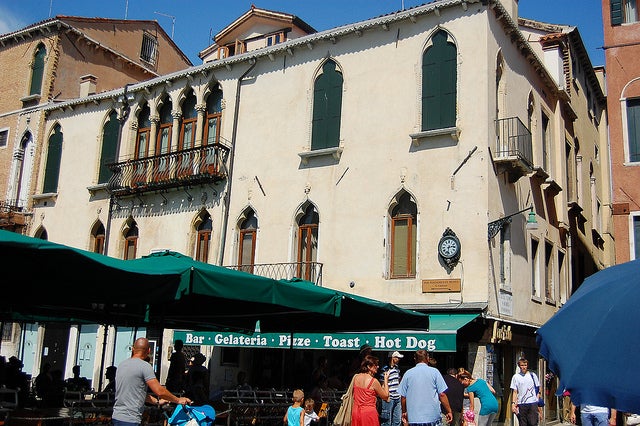
Ca’ Venier
Next we will go to Jacopo Tintoretto’s house in the Cannaregio district. Tintoretto lived in this house from 1574 until his death in 1594. Tintoretto, a prominent Venetian painter, was best known for The Worship of the Golden Calf, The Presentation of the Virgin in the Temple, and The Last Judgment, among others. He is also credited with painting this 1574 portrait of Veronica Franco which she refers to in her published Letter#21.
To get to Tintoretto’s house, walk back to the Rialto Vaporetto station and take the n. 2 or the n. 1 in the direction of Ple. Roma. Get off at San Marcuola (the Venice casino) and walk to the red ‘A’ on Fondamenta Mori.

I know it looks far in the map, but it’s really not (like most places in Europe, Venice is packed in a few miles). It’s about a 10 – 15 minute walk along the lesser-known streets of Venice. What’s not to love?

Ca’ Tintoretto
Today, Ca’ Tintoretto is privately owned and has been broken up into a series of renovated short-term rental apartments. If you wish, you can actually rent an apartment on the first floor during your stay in the city.

Facade of Ca’Tintoretto
Day Two
We start off on the island of Dorsoduro where we we can still find vestiges of Veronica Franco’s early life and family history.

Portrait by Tintoretto, 1574
Once more, the n. 2 and the n.1 vaporetto lines are your friends. Get off at the Accademia stop. From there, the Sant’ Agnese piazza is at a stone’s throw (literally next to the Accademia Museum).

Door of the Parrochia (notice the emblem)
At the time of Franco’s birth in 1546 she was living in the parish region of the Chiesa di Sant’Agnese which was founded in 1081. Unfortunately, this church was burnt down in 1105 during a great fire that destroyed large parts of Venice; however, it was reconstructed that same year. Over one of the doors, you can see the remains of the Franco family shield (in its day it would’ve been painted and looked like this).

Because Veronica’s branch of the Franco family were Cittadini Originari with residence in this sestiere, their coat of arms was placed over the Parrochia’s entrance as a way to honor their patronage.
Once you’re done, cross the Rio Terra Carita on your way to the vaporetto and pay a visit to the renowned Accademia Museum! Here you can find paintings by renowned painters such as Leonardo da Vinci, Titian, Tintoretto, Giorgione, Veronese and Le Brun.
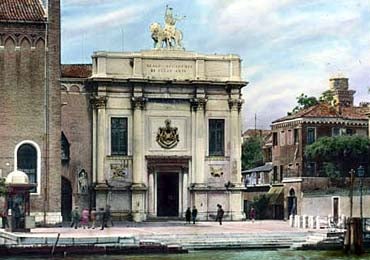
Gallerie dell’ Accademia (UCSC Library)
After strolling through the museum and grabbing a bite to eat, visit the Calle Franchi, a street named after Veronica’s family. To get there, walk back to the Parrochia di Sant’Agnese and from there walk to the Calle Chiesa and make a right until you reach the Fondamenta Bragadin where you make a left. Stroll along the canal about two blocks, and you will reach the lesser-known Calle Franchi. If you get lost, ask for the Hotel American which is at the corner of the Calle Franchi and the Fondamenta.
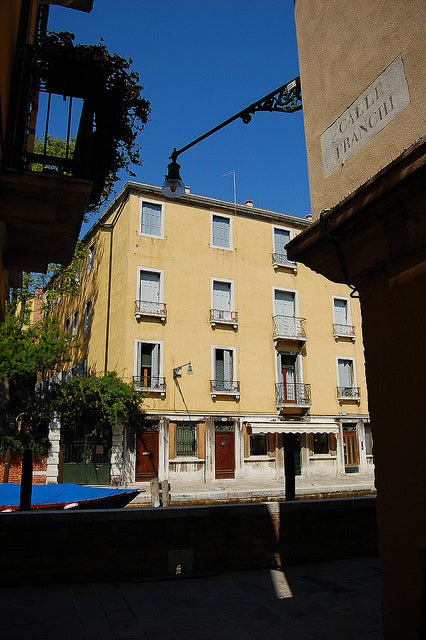
Interestingly enough, the Calle Franchi is across from the Fondamenta Venier (where the yellow building is)
Calle Franchi is a quiet, residential street. Please keep this in mind when visiting and try not to disturb the mostly elderly residents by taking too many photos or making noise.
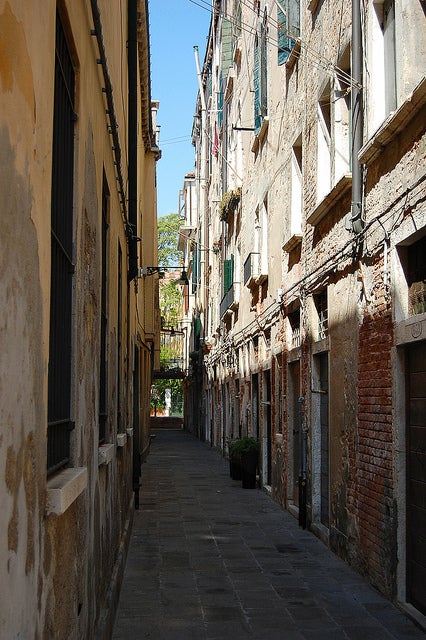
Calle Franchi from the back, looking out.
The last leg of the trip will take us to the sestiere of San Polo. Go back to the Accademia stop and take the n.1 vaporetto towards Ple. Roma and get off at the San Silvestro stop. From here, we go to the infamous “Ponte delle Tette,” a small bridge where prostitutes would display their naked breasts to entice customers.
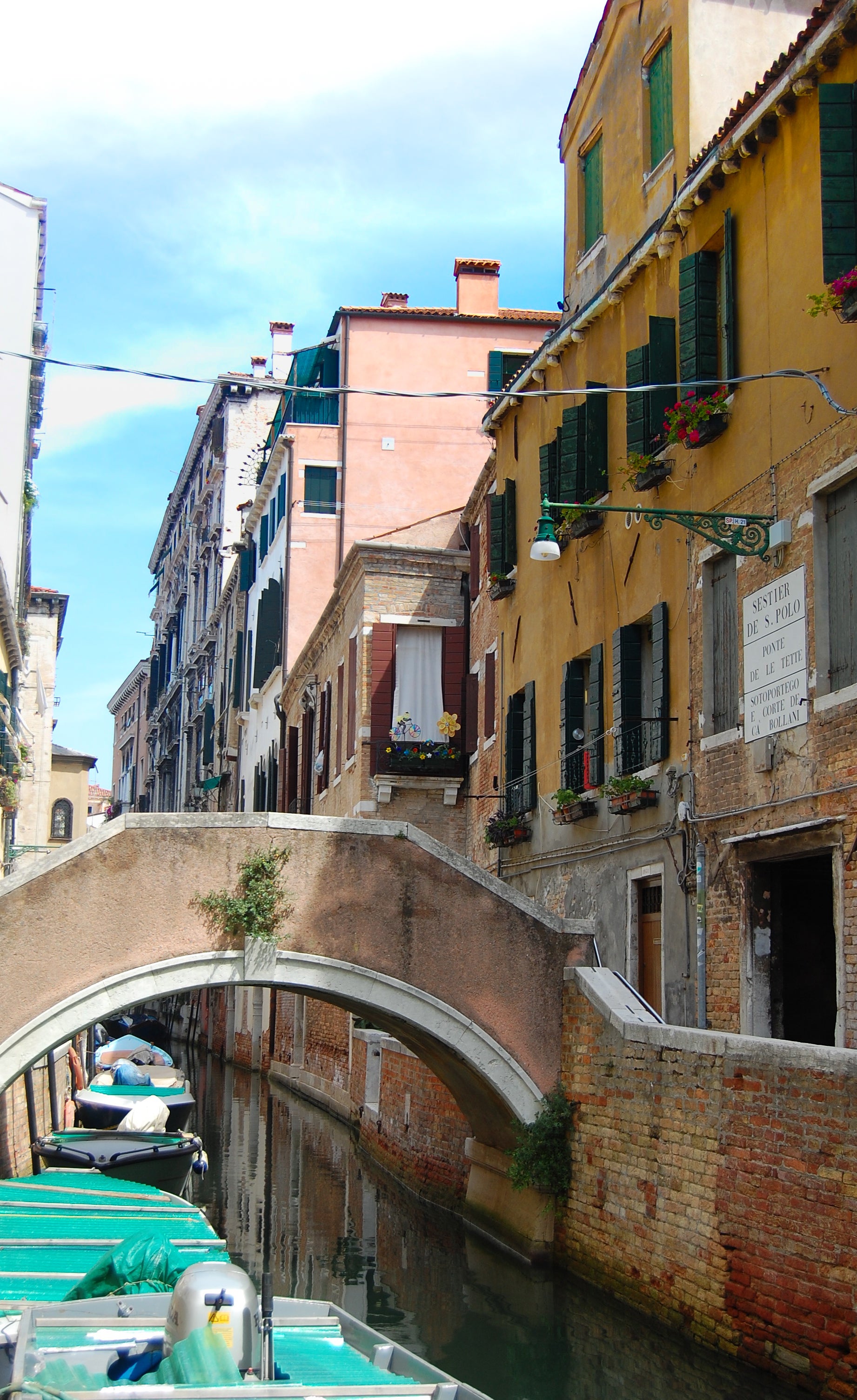
Ponte delle Tette
This topless custom was instituted by the government itself as a desperate measure to counteract homosexuality which was rampant in 16th century Venice. In the 17th century, however, younger prostitutes were no longer restricted to the Ca’ Rampani area of Venice, and so the district was inhabited by old prostitutes.
Nowadays, this bridge is not well-known and can be hard to find, especially since it doesn’t appear on most tourist (or google) maps. However, here are my directions for it:
Get off at the San Silvestro vaporetto stop and cross the Campo Sant’Aponal. Cross the bridge; you should be on the fondamenta Fruttarola. From here make a right on the first street: Calle Salviati. Then take a right on the first street on your right. You will hit the Rio Terra Rampani. Make a left and walk all the way down. The bridge will be at the end of the street.

While you’re in the area, the famous “Trattoria Antiche Carampane” on the Rio Terra Rampani is worth mentioning. This restaurant is a Venetian-food staple and a favorite haunt of politicians and celebrities for authentic Venetian cuisine (keep in mind they’re closed on Sundays and Mondays).

The well-known Zagat-rated restaurant, “Antiche Carampane,” is right next to the bridge.
This itinerary was composed by USC undergrad Francesca Martens.